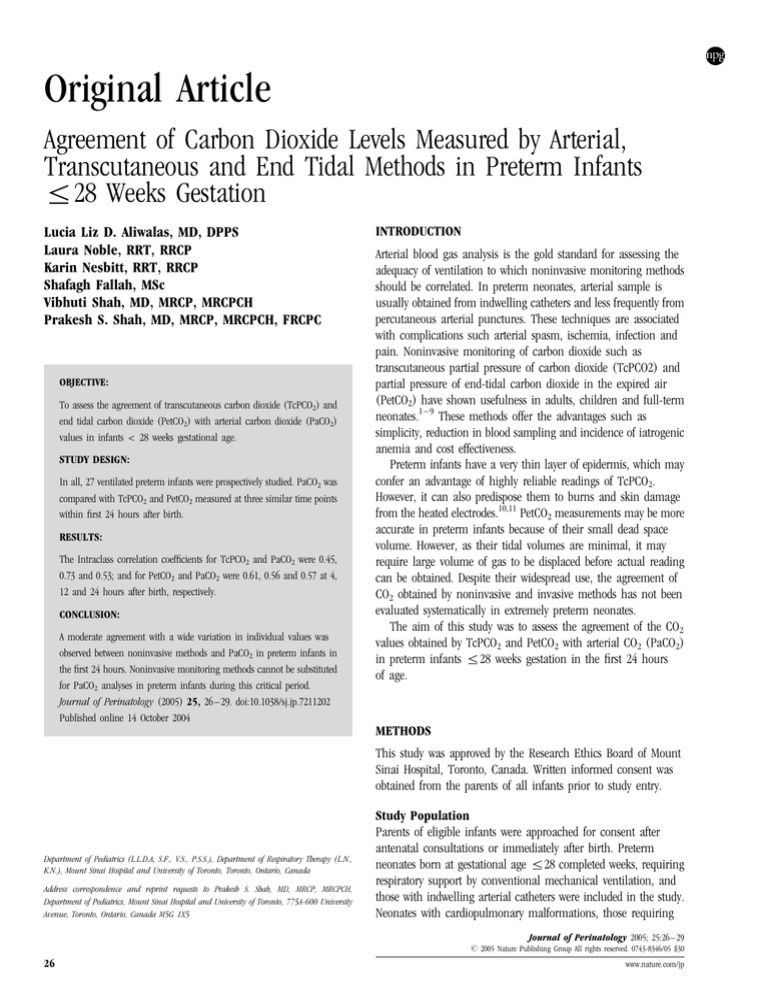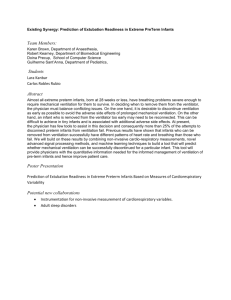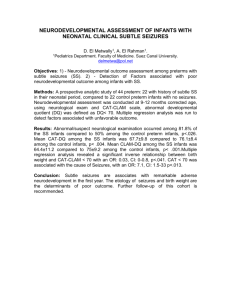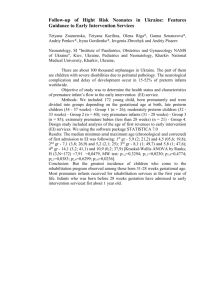
Original Article
Agreement of Carbon Dioxide Levels Measured by Arterial,
Transcutaneous and End Tidal Methods in Preterm Infants
r28 Weeks Gestation
Lucia Liz D. Aliwalas, MD, DPPS
Laura Noble, RRT, RRCP
Karin Nesbitt, RRT, RRCP
Shafagh Fallah, MSc
Vibhuti Shah, MD, MRCP, MRCPCH
Prakesh S. Shah, MD, MRCP, MRCPCH, FRCPC
OBJECTIVE:
To assess the agreement of transcutaneous carbon dioxide (TcPCO2) and
end tidal carbon dioxide (PetCO2) with arterial carbon dioxide (PaCO2)
values in infants < 28 weeks gestational age.
STUDY DESIGN:
In all, 27 ventilated preterm infants were prospectively studied. PaCO2 was
compared with TcPCO2 and PetCO2 measured at three similar time points
within first 24 hours after birth.
RESULTS:
The Intraclass correlation coefficients for TcPCO2 and PaCO2 were 0.45,
0.73 and 0.53; and for PetCO2 and PaCO2 were 0.61, 0.56 and 0.57 at 4,
12 and 24 hours after birth, respectively.
CONCLUSION:
A moderate agreement with a wide variation in individual values was
observed between noninvasive methods and PaCO2 in preterm infants in
the first 24 hours. Noninvasive monitoring methods cannot be substituted
for PaCO2 analyses in preterm infants during this critical period.
Journal of Perinatology (2005) 25, 26–29. doi:10.1038/sj.jp.7211202
Published online 14 October 2004
INTRODUCTION
Arterial blood gas analysis is the gold standard for assessing the
adequacy of ventilation to which noninvasive monitoring methods
should be correlated. In preterm neonates, arterial sample is
usually obtained from indwelling catheters and less frequently from
percutaneous arterial punctures. These techniques are associated
with complications such arterial spasm, ischemia, infection and
pain. Noninvasive monitoring of carbon dioxide such as
transcutaneous partial pressure of carbon dioxide (TcPCO2) and
partial pressure of end-tidal carbon dioxide in the expired air
(PetCO2) have shown usefulness in adults, children and full-term
neonates.1–9 These methods offer the advantages such as
simplicity, reduction in blood sampling and incidence of iatrogenic
anemia and cost effectiveness.
Preterm infants have a very thin layer of epidermis, which may
confer an advantage of highly reliable readings of TcPCO2.
However, it can also predispose them to burns and skin damage
from the heated electrodes.10,11 PetCO2 measurements may be more
accurate in preterm infants because of their small dead space
volume. However, as their tidal volumes are minimal, it may
require large volume of gas to be displaced before actual reading
can be obtained. Despite their widespread use, the agreement of
CO2 obtained by noninvasive and invasive methods has not been
evaluated systematically in extremely preterm neonates.
The aim of this study was to assess the agreement of the CO2
values obtained by TcPCO2 and PetCO2 with arterial CO2 (PaCO2)
in preterm infants r28 weeks gestation in the first 24 hours
of age.
METHODS
This study was approved by the Research Ethics Board of Mount
Sinai Hospital, Toronto, Canada. Written informed consent was
obtained from the parents of all infants prior to study entry.
Department of Pediatrics (L.L.D.A, S.F., V.S., P.S.S.), Department of Respiratory Therapy (L.N.,
K.N.), Mount Sinai Hospital and University of Toronto, Toronto, Ontario, Canada
Address correspondence and reprint requests to Prakesh S. Shah, MD, MRCP, MRCPCH,
Department of Pediatrics, Mount Sinai Hospital and University of Toronto, 775A-600 University
Avenue, Toronto, Ontario, Canada M5G 1X5
Study Population
Parents of eligible infants were approached for consent after
antenatal consultations or immediately after birth. Preterm
neonates born at gestational age r28 completed weeks, requiring
respiratory support by conventional mechanical ventilation, and
those with indwelling arterial catheters were included in the study.
Neonates with cardiopulmonary malformations, those requiring
Journal of Perinatology 2005; 25:26–29
r 2005 Nature Publishing Group All rights reserved. 0743-8346/05 $30
26
www.nature.com/jp
Agreement of CO2 by Noninvasive Methods
high-frequency ventilation and those who had received sodium
bicarbonate infusion within 60 minutes prior to blood sampling
were excluded.
Study Design
After providing standard resuscitation in accordance to the
neonatal resuscitation protocol guidelines, umbilical vessels were
catheterized upon the discretion of the attending physician. Three
arterial blood gas samples were drawn: (a) first within 4 hours of
age, (b) second at 12 hours of age and (c) third at 24 hours of
age. These samples were analyzed immediately in the central
laboratory using the CIBA - Cornings 865 series (CIBA, USA) blood
gas analyzer. Probes for both TcPCO2 and PetCO2 were placed prior
to blood sampling at each time. The values of the TcPCO2, PetCO2,
mean blood pressure and ventilatory parameters at the time of
sampling were recorded. If the infant was extubated prior to
completion of three sampling, he/she was excluded from the study.
The Linde MicroGas 7650 (Kontron, USA) monitor was used for
TcPCO2 measurement. In this technique, CO2 was measured
potentiometrically by determining the pH of an electrolyte. The
electrolyte solution was provided within a hydrophilic spacer, which
was placed on top of the sensing area. The spacer was covered by a
highly gas permeable, hydrophobic membrane. The sensor was
heated to a constant temperature of 441C. For the study purposes
barometric pressure was set at 750 mmHg, PCO2 temperature
correction was set to auto, and the PCO2 metabolic constant was set
at 5 mmHg. Each baby had the sensor timed out at 4 hours due to
concerns of skin injury, erythema and skin craters with TcPCO2
probes.11,12 The double-sided adhesive ring was applied to the
sensor. A small drop of contact gel was applied to the center of the
sensor. The sensor was placed over nonbony structures with gentle
pressure applied to the center of the sensor to ensure removal of
any air pockets and to spread the contact gel.
The Nellcor NPB-70 (Mallinckrodt, Inc; USA.) hand-held
sidestream capnograph was used to measure the partial pressure of
carbon dioxide in the expired air (PetCO2) which uses microstream
infrared spectroscopy to measure the concentration of the
molecules that absorb infrared light. Because the absorption is
proportional to the concentration of the absorbing molecule, the
concentration can be determined by comparing its absorption to
that of a known standard. Therefore, no compensation is required
when different concentrations of nitric oxide, oxygen, anesthetic
agent or water vapor are present in the inhaled or exhaled breath.
A Microstream Circuit FilterLinet H Set (Mallinckrodt Inc; USA)
was used. After a 15-second self-test, the FilterLine was attached
between the endotracheal tube and the ventilator circuit and the
readings were recorded.
Statistical Analysis
An intraclass correlation coefficient (ICC) of 0.60 for CO2
assessment by PetCO2 or TcPCO2 compared to PaCO2 measurement
Journal of Perinatology 2005; 25:26–29
Aliwalas et al.
for preterm infants has been reported in a previous study.5 A total
of 27 preterm infants were required to demonstrate an agreement level of 0.80 at a 5% type I error and 20% type II error at
any time of sampling.13 Bland Altmann analysis was used to
determine precision and bias.14 The significance of the effect of
different factors such as birth weight (<750 and Z750 g),
mean blood pressure, mean airway pressure (r7.5 and >7.5 mm
of H2O), site of transcutaneous probe application (chest and
abdomen or thigh) on the differences between the measurements were analyzed using the Wilcoxon two-sample test and
regression analysis.
RESULTS
The study was conducted from May to December 2003 in the
neonatal intensive care unit of Mount Sinai Hospital, Toronto,
Canada. A total of 26 parents were approached, 33 (16 singletons,
four sets of twins, three sets of triplets) patients were enrolled in the
study and 27 infants completed the study. Two infants were
extubated prior to the completion of data collection of three
samples, two infants did not have indwelling arterial catheter, one
infant needed high-frequency oscillatory ventilation after the first
sample, and in one infant PetCO2 measure was not obtained for
the third sample. All infants (17 male) had a diagnosis of
respiratory distress syndrome. The mean (SD) gestational age was
26.3 (1.0) weeks and birth weight was 875 (141) g. All patients
received surfactant (BLESt, London, ON, Canada) within 15 to 30
minutes after birth.
The ICC, the mean differences (bias) and Standard Error of
the Mean (SEM) of the differences (precision) in the readings
between PaCO2 – TcPCO2 and PaCO2 – PetCO2 at 4, 12 and
24 hours are reported in Table 1. The results of the Wilcoxon
two-sample test and regression analysis of the effect of the
different parameters are reported in Table 2. The differences
between the PaCO2 and TcPCO2; and PaCO2 and PetCO2 at
4 hours of age against gold standard PaCO2 values are plotted in
Figures 1 and 2.
Table 1 Intraclass Correlation Coefficient, Mean Difference and
Standard Error of the Mean Difference of CO2 Measurements from
PaCO2 at Three Time Points
Measurement
ICC
Mean
difference
Standard error of
mean difference
TcPCO2 within 4 hours
TcPCO2 at 12 hours
TcPCO2 at 24 hours
PetCO2 within 4 hours
PetCO2 at 12 hours
PetCO2 at 24 hours
0.45
0.73
0.53
0.61
0.56
0.57
2.2
4.4
2.6
0.3
2.4
1.9
2.3
1.2
1.8
2.2
1.4
1.8
27
Aliwalas et al.
Agreement of CO2 by Noninvasive Methods
Table 2 Wilcoxon Two-Sample Test and Regression Analysis of
Different Parameters at 4 hours of age
Variable
TcPCO2 – PaCO2 at
4 hours
Median
(IQR)
Birth weight r750 g
Birth weight >750 g
Site of application
Abdomen and chest
Thigh
MAP r7.5
MAP >7.5
MBP
PetCO2 – PaCO2 at
4 hours
p
Median
(IQR)
p
2 (0,7)
4 (0,8)
0.77
4 (15,3)
1 (5,7)
0.45
2 (1,7.5)
4 (1,16)
0.23
0 (6,12)
2 (10,2)
0.4
0.27
MAP F mean airway pressure in cm of H2O; MBP F mean blood pressure in
mmHg; IQR F interquartile range.
Figure 2. Bland-Altman plot of the difference between PaCO2 and
PetCO2 at 4 hours of age.
Figure 1. Bland-Altman plot of the difference between PaCO2 and
TcPCO2 at 4 hours of age.
DISCUSSION
We found a moderate agreement between both noninvasive
methods and PaCO2 as reflected by the ICC values at all three time
points of sampling. The values of bias and precision around the
differences in the measurements reflected wide variation among
individual patients. Birth weight, site of transcutaneous probe
application, mean blood pressure and mean airway pressure had
no influence on the agreement.
Hand et al.1 in a study of 12 preterm infants (51 samples)
observed a linear correlation between TcPCO2 and PaCO2
28
(r ¼ 0.71, slope ¼ 0.9), but not with PetCO2 (r ¼ 0.52,
slope ¼ 0.42). Geven et al2 in a study of 12 infants (72 samples)
observed good correlation with TcPCO2 (r ranged from 0.29 to
þ 0.95) but not PetCO2 (r ranged from 0.99 to þ 0.97).
Watkins and Weindling3 in a study of 19 infants (69 samples)
observed poor overall correlation of the PetCO2 and PaCO2
(r ¼ 0.39, p<0.01). On the contrary, Wu et al4 in a study of 60
infants observed good correlation between PetCO2 and PaCO2 in
both term infants (44 samples, r ¼ 0.78, p<0.001) and preterm
infants (86 samples, r ¼ 0.85, p<0.001). Nangia et al5 in a study
of 152 samples observed a significant correlation between PaCO2
and PetCO2 in preterm infants <32 weeks (p ¼ <0.01).
Thus, previous studies to assess correlation have found
conflicting results. We elected to study infants r28 weeks at birth
because the number of extremely preterm infants enrolled in the
previous studies is limited. We studied preterm infants in the
immediate postnatal period because unintentional hypocarbia15 is
common during the initial period in preterm infants and this could
lead to long-term pulmonary damage, that is, chronic lung disease
of preterm infants. All the infants had similar respiratory illness
pattern (RDS) and all infants were studied at the same time points
in their illness. This confirms the homogeneity of our data. All
infants had three sets of data that were analyzed individually
allowing statistical independence of the measures. This is a unique
characteristic of our study, consistently ignored in all previous
studies. Multiple measures from a single patient could skew the
results of correlation. We did not evaluate the agreement between
PaCO2 and other noninvasive methods beyond 24 hours of age as
the number of infants who may get extubated remains higher and
Journal of Perinatology 2005; 25:26–29
Agreement of CO2 by Noninvasive Methods
will result in incomplete data set, however, such study will be very
important for the management of infants who require mechanical
ventilation beyond 24 hours of age.
Noninvasive monitoring techniques are widely accepted and
used in the adult and pediatric population. In neonates, small tidal
volume, higher respiratory rate resulting in shorter expiratory time
could result in the lack of true alveolar gas being measured and
explain wide variation in PetCO2 values. Meridith and Monaco16
reported the difference of 8 to 18 mm of Hg between PaCO2 and
PetCO2 (similar to our findings of 22 to 21 mm of Hg) and
suggested inability to predict PaCO2 from PetCO2, but mentioned
that it may be useful for trends. Our findings confirms lack of
reliability, however, due to the nature of the design of our study we
are not able to comment on the usefulness to assess the changes in
the trend. TcPCO2 is expected to correlate well with PaCO2 because
of the thin layer of epidermis. Studies have shown that tissue
perfusion and acidosis may alter such agreement.17,18 Although we
were not able to find differences in the correlation based on blood
pressure, the sample size to assess the impact was probably
inadequate. It is also possible that the technology, as currently
available, is not yet ready to replace the gold standard. The
apparent discrepancy in our results and that of others illustrate the
need for careful and systematic evaluation of technological
advances before they are adopted in the routine practice.
Thus, based on our findings of only moderate correlation and
wide individual variability, we suggest that noninvasive monitoring
methods, as used in the study, cannot be substituted for PaCO2
analyses in preterm infants.
Acknowledgements
We sincerely thank the parents of all preterm infants who consented to participate
in this study and the respiratory therapists and nursing staff working in the NICU
at Mount Sinai Hospital for their relentless support during this study.
References
1. Hand IL, Shepard E, Krauss AN, Auld PA. Discrepancies between
transcutaneous and end tidal carbon dioxide monitoring in critically
ill neonate with respiratory distress syndrome. Crit Care Med 1989;17:
556–9.
Journal of Perinatology 2005; 25:26–29
Aliwalas et al.
2. Geven WB, Nagler E, de Boo T, Lemmens W. Combined transcutaneous
oxygen, carbon dioxide tensions and end-expired CO2 levels in severely ill
newborns. Adv Exp Med Biol 1987;220:115–20.
3. Watkins AM, Weindling AM. Monitoring of end tidal CO2 in neonatal
intensive care. Arch Dis Child 1987;62:837–9.
4. Wu CH, Chou HC, Hsieh WS, Chen WK, Huang PY, Tsao PN. Good
estimation of arterial carbon dioxide by end tidal carbon dioxide
monitoring in the neonatal intensive care unit. Pediatric Pulmonol
2003;35:292–5.
5. Nangia S, Saili A, Dutta AK. End tidal carbon dioxide monitoring F its
reliability in neonates. Indian J Pediatr 1997;64:389–94.
6. Tobias JD, Meyer DJ. Noninvasive monitoring of carbon dioxide during
respiratory failure in toddlers and infants: end-tidal versus transcutaneous
carbon dioxide. Anesth Analg 1997;85:55–8.
7. Healey CJ, Fedullo AJ, Swinburne AJ, Wahl GA. Comparison of noninvasive
measurements of carbon dioxide tensions during withdrawal from
mechanical ventilation. Crit Care Med 1987;15(8):764–8.
8. Reid CW, Martineua RJ, Miller DR, Hull KA, Baines J, Sullivan PJ.
Comparison of transcutaneous end tidal and arterial measurements of
carbon dioxide during general anesthesia. Can J Anesth 1992;39:31–6.
9. Yamanaka MK, Sue DY. Comparison of arterial-end-tidal PCO2 difference
and dead space/tidal volume ratio in respiratory failure. Chest 1987;92:
832–5.
10. Cassady G. Transcutaneous monitoring in the newborn infant. J Pediatr
1983;103:837–48.
11. Boyle RJ, Oh W. Erythema following transcutaneous PO2 monitoring.
Pediatrics 1980;65:333–4.
12. Golden SM. Skin craters F a complication of transcutaneous oxygen
monitoring. Pediatrics 1981;67:514–6.
13. Walter SD, Eliasziw M. Sample size and optimal designs for reliability
studies. Stat Med 1998;17:101–10.
14. Bland JM, Altman DG. Statistical methods for assessing agreement between
two methods of clinical measurement. Lancet 1986;1:307–10.
15. Tracy M, Downe L, Holberton J. How safe is intermittent positive pressure
ventilation in preterm babies ventilated from delivery to newborn intensive
care unit? Arch Dis Child Fetal Neonatal Ed 2004;89:F84–7.
16. Meredith KS, Monaco FJ. Evaluation of a mainstream capnometer and
end-tidal carbon dioxide monitoring in mechanically ventilated infants.
Pediatr Pulmon 1990;9:254–9.
17. Cabal LA, Hodgman J, Siassi B, et al. Factors affecting heated
transcutaneous PO2 and unheated transcutaneous PCO2 in preterm infants.
Crit Care Med 1981;9:298.
18. Bhat R, Kim WD, Shukla A, et al. Simultaneous tissue pH and
transcutaneous carbon dioxide monitoring in critically ill neonates. Crit
Care Med 1981;9:744.
29








